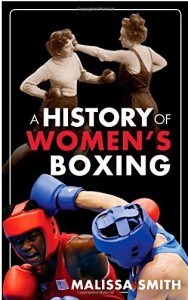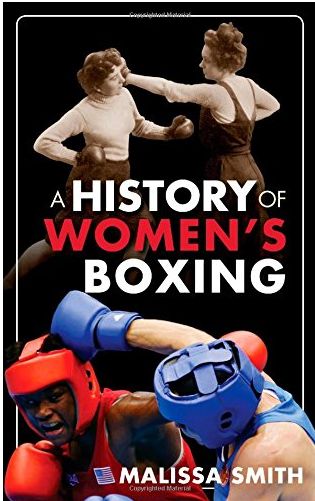A History of Women’s Boxing
by Malissa Smith
 Records of modern female boxing date back to the early eighteenth century in London, and in the 1904 Olympics an exhibition bout between women was held. Yet it was not until the 2012 Olympics-more than 100 years later-that women’s boxing was officially added to the Games. Throughout boxing’s history, women have fought in and out of the ring to gain respect in a sport traditionally considered for men alone. The stories of these women are told for the first time in this comprehensive work dedicated to women’s boxing.
Records of modern female boxing date back to the early eighteenth century in London, and in the 1904 Olympics an exhibition bout between women was held. Yet it was not until the 2012 Olympics-more than 100 years later-that women’s boxing was officially added to the Games. Throughout boxing’s history, women have fought in and out of the ring to gain respect in a sport traditionally considered for men alone. The stories of these women are told for the first time in this comprehensive work dedicated to women’s boxing.
A History of Women’s Boxing traces the sport back to the 1700s, through the 2012 Olympic Games, and up to the present. Inside-the-ring action is brought to life through photographs, newspaper clippings, and anecdotes, as are the stories of the women who played important roles outside the ring, from spectators and judges to managers and trainers. This book includes extensive profiles of the sport’s pioneers, including Barbara Buttrick whose plucky carnival shows launched her professional boxing career in the 1950s; sixteen-year-old Dallas Malloy who single-handedly overturned the strictures against female amateur boxing in 1993; the famous “boxing daughters” Laila Ali and Jacqui Frazier-Lyde; and teenager Claressa Shields, the first American woman to win a boxing gold medal at the Olympics.
Rich in detail and exhaustively researched, this book illuminates the struggles, obstacles, and successes of the women who fought-and continue to fight-for respect in their sport. A History of Women’s Boxing is a must-read for boxing fans, sports historians, and for those interested in the history of women in sports.
About the Author: Malissa Smith is an amateur boxer and maintains a popular blog about the sport-Girlboxing. She writes frequently on the topic of women’s boxing and has appeared as a guest on the radio show Courts & Sports to discuss women’s boxing history and women’s boxing in the Olympics. Smith is a board member of the International Women’s Boxing Hall of Fame (IWBHF).
This book is available at Amazon.com and Barnes & Noble.
**********
HISTORY OF AND TRIBUTE TO WOMEN’S BOXING
Book Review and Interview by Roger Zotti
In the end, [writing A History of Women’s Boxing] was truly a labor of love and I truly hope other historians will pick up the gauntlet.
Malissa Smith
1
Rich in detail and written in an exceptionally readable prose voice, Malissa Smith’s much needed and skillfully researched A History of Women’s Boxing (Rowman and Littlefield) is essential reading for both boxing historians and fans.
In addition to being a wide-ranging history of women’s boxing and a tribute to women boxers past and present, Malissa’s book is, as she rightly believes, “an interesting lens with which to view the place of women in society as a whole.”
Interview
I began my interview with Malissa by asking her why she wrote her book. Her reply: “I had the opportunity to present a brief overview of the history of the sport at an academic conference which included sports in popular culture. As a result of my presentation, I was approached to write the first history of women’s boxing. It was an exciting opportunity I felt both awed and proud to undertake.”
Regarding the book’s major themes, Malissa said: “One is the understanding that women have participated and performed boxing since its modern inception by James Figg in the early 1720.
“And while there is not much in the written record or such things as clear understandings of sanctioned championships, et al., women still practiced the sport and were recognized for their accomplishments.
“In the United States where boxing began to be appreciated as a sport in the post-Civil War period, women also came to perform the sport professionally in the venue of the day—mostly on the variety theater stage. The popularity of such entertainments saw it cross-over into the popular culture as a sport women could practice for exercise and enjoyment.
“Given the sport has always been thought of as a particularly masculine endeavor, the ‘line’ for what was and was not allowed for women to perform put boxing squarely in the cross of public opinion with, at times, legal consequences.
The book was challenging to write, Malissa said, because of the “paucity of public records—which meant hours and hours and hours of combing old newspaper articles (luckily online) using a variety of search terms to find information on women’s participation in boxing.
“Another challenge was writing about the contemporary practitioners of the sport. Those choices are ultimately subjective, so I really needed to set myself clear guidelines to makes some of the decisions which included, types of fights and opponents, titles/opportunities (especially difficult in the 1970s-1980s), confirmation/validation of fighting abilities and veracity of accounts of types of fights, record of wins and losses, etc.”
Also, Malissa wanted to make certain she was accurate in “portraying the experiences of the fighters and the issues thrown in the way of female fighters as they attempted to negotiate varying boxing commissions and the amateur boxing organizations.”
2
I’ll run through Smith’s book concentrating on four of its many highlights.
Fathers and Daughters . . .
Weighing 180 pounds and standing 5’11, Freeda George Foreman, made her professional boxing debut in 2000, at the Regent Hotel and Casino, in Las Vegas on Father’s Day, June 18. Her opponent, Laquanda Landers, was also making her professional ring debut. Freeda scored a second round KO.
And what did Freeda’s former heavyweight champion father, George Foreman, think about her becoming a professional prizefighter? “He flat-out doesn’t like it,” Smith quotes her as saying. “But I do have his love and respect. That’s what counts.”
Foreman retired in 2001 with a 5-1 record.
How did Jacqui Frazier-Lyde’s father, Joe Frazier, another former heavyweight champion, react to his daughter’s career choice? According to Smith, he “wasn’t exactly thrilled with the idea, but thought her progress in the ring was great.”
(On June 8, 2001, in what was the most important fight of her career, she battled Laila Ali, Muhammad Ali’s daughter, and, as boxing fans know, Ali won a majority decision.)
In 2004 Frazier-Lyde, who is now practices law in Philadelphia, retired with a 13-1 record.
Irichelle Duran, who fought professionally from 2000 to 2002 and was nicknamed “Pretty Girl,” retired with a 1-2 record. Ah! Her father, the great lightweight champion Roberto Duran, Smith writes, “reportedly didn’t speak to her for a week after she made her announcement [to become a professional boxer].”
Promoter Harry Hill . . .
In “Victorian Ladies Boxing” we learn about Harry Hill and his Variety Theater, “a notorious nightclub,” Smith writes, “in the tradition of Bowery Taverns from the 1840s band 1850s . . . .”
Hill’s “showman’s eye,” Smith continues, “saw him [put] on the first ‘acknowledged’ female prizefight in America . . . and thus began the era of female boxing shows, championships, and other related entertainments that spread from Hill’s establishment on across the country . . . .”
And yes, that boxing contest at Hill’s in 1876, so popular, encouraged him “to promote nightly female boxing events.”
Pioneers . . .
In “Boxing in the Age of the Mighty Atom,” Smith profiles many trailblazers of women’s professional boxing, including Barbara Buttrick and JoAnn Hagen.
After establishing her boxing credentials in England during the 1940s—she was born in Yorkshire—Buttrick, who stood 4’ll, weighed ninety pounds, and nicknamed “The Mighty Atom,” journeyed to America in the 1950s, where, in 1954, she suffered the only loss in her impressive career to the bigger Hagen.
Smith quotes Hagen, a graceful boxer-puncher, as saying Buttrick was “the best and toughest fighter she’d ever met” and “I have a split lip and cut nose to prove it.”
Hagen was once a guest on the popular Steve Allen Show, along with Phyliss Kugler, in 1956. They appeared in evening dresses and later in their boxing attire. Hagen briefly sparred with Allen and then with Kugler, whom she fought a year later.
The talented Buttrick retired from boxing with a 30-1-1 record in 1956; Hagen retired in 1954.
Ali vs. Martin . . .
In the “Christy Martin and the Pinking of the Velvet Ropes” chapter, we learn Martin had become, Smith writes, “the public symbol of women’s boxing almost from the beginning of her professional career in the 1990s” and “had pushed her earnings higher than anyone in the women’s boxing had before.”
Take note: Martin, who was born June 12, 1968, in Mullens, West Virginia, and had signed with Don King, made it a policy to come “into the ring clad in pink satin shorts and a matching pink satin jacket and wearing a hint of lipstick . . .” For many fight fans, male and female, here was “an attractive woman who could actually box well.”
Turning to the “Women’s Boxing and the Fame Game” chapter, Smith recounts Martin’s fight with Laila Ali, one of the best women boxers ever to lace up the leather mittens. Undefeated in fifteen bouts, Ali hoped to displace “Martin as the most bankable female boxing star.” Bigger by twenty pounds, taller by six inches, and younger by eleven years, she was confident she could set “Martin back a notch to ‘pioneer status.’”
So . . . it was super middleweight champion Ali going against the legendary fourteen-year veteran Martin.
They battled on August 23, 2003. The place: The Mississippi Coast Coliseum in Biloxi, Mississippi. At stake: The International Boxing Association World Female Super Middleweight title. And the result: “Martin fought valiantly, but Ali was too big and strong and skillful . . . A battered Martin, in trouble as early as the first round, was counted out in the fourth round.
(When Rocky Marciano knocked out Joe Louis in 1951, a sports journalist said it was the end of an era, which also is true of Ali’s victory over Martin.)
Ali held several super middleweight titles during her career and retired in 2007 with a 24-0 record (21 knockouts); Martin called it quits in 2012 with a 49-7 record (31 knockouts).
A regular contributor to the IBRO Journal, Roger Zotti is the author of two boxing books, Friday Night World and The Proper Pugilist.
